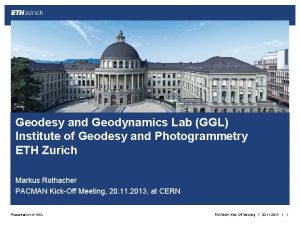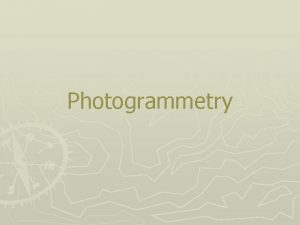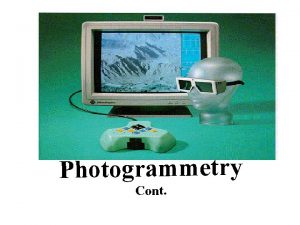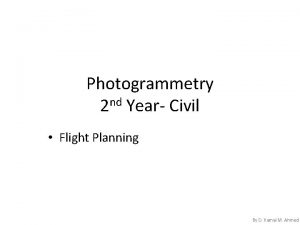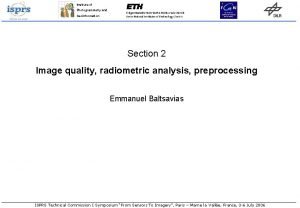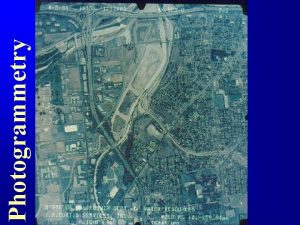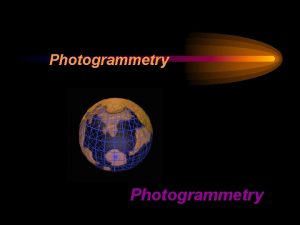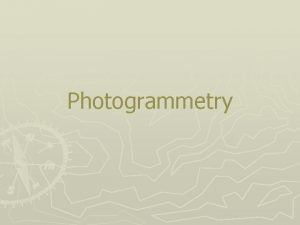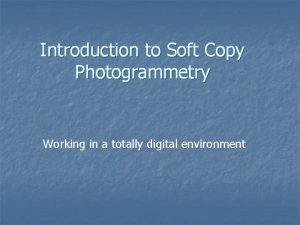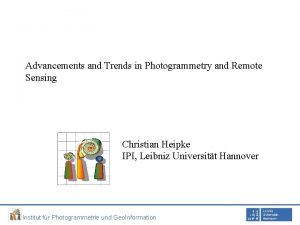Photogrammetry Introduction Photogrammetry the science art and technology





















- Slides: 21

Photogrammetry

Introduction • • • Photogrammetry: the science, art, and technology of obtaining reliable information from photographs. Two major areas: metric, and interpretative. Terrestrial and aerial Photogrammetry. Uses of Photogrammetry: topographic mapping, determine precise point coordinates, cross sections, deflection monitoring, and many other applications. Why Photogrammetry?



Aerial Cameras • • For precise results, cameras must be geometrically stable, fast, have efficient shutters, sharp lenses Single-lens frame cameras: figure 27 -2 – – – most used format size is 9”, focal length 6 in components: lens, shutter, diaphragm, filter, focal plane, fiducial marks. shutters can be operated manually or automatically. The camera could be leveled regardless of the plane orientation. Exposure station and principal point. Camera calibration.



Aerial Photographs • • True Vertical: if the camera axis is exactly vertical, or near vertical. Tilted Photographs Oblique photographs: high and low Vertical Photos are the most used type for surveying applications



Geometry of Vertical Photographs • • • Figure 27 -6 Define: image coordinate system (right handed), principal point, exposure station. Measurements could be done using negatives or diapositives, same geometry. Strips and Blocks. Sidelap (about 30%), and Endlap (about 60%), why?




Scale of a Vertical Photograph Figure 28 -6 • Scale of a photograph is the ratio of a distance on a photo to the same distance on the ground. • Photographs are not maps, why? • Scale of a map and scale of a photograph. • Orthphotos f • Scale (s) at any point: S= H-h f • Average scale of a photograph: Savg = H - h avg • If the f, H, and h are not available, but a map is available then: photo distance X map scale Photo Scale = map distance


Ground Coordinates from a Single Vertical Photograph • • Figure 27 -8 With image coordinate system defined, we define an arbitrary ground coordinate system. That ground system could be used to compute distances and azimuths. Coordinates can also be transformed to any system In that ground system: Xa = xa * (photograph scale at a) Y = y * (photograph scale at a)


Relief Displacement on a Vertical Photograph • • Figure 27 -9 The shift of an image from its theoretical datum location caused by the object’s relief. Two points on a vertical line will appear as one line on a map, but two points, usually, on a photograph. In a vertical photo, the displacement is from the principal point. Relief displacement (d) of a point wrt a point on the datum : rh d= H where: r is the radial distance on the photo to the high point h : elevation of the high point, and H is flying height above datum • Assuming that the datum is at the bottom of vertical object, H is the flying height above ground, the value h will compute the object height.

ra/R = f/H Or: ra *H = R * f ----(1) rb/R = f/(H-h) Or: rb * (H-h) =R * f ---(2) Then from (1) and (2); Or ra *H = rb * (H-h) then; D = rb - ra = rb *hb /H

Flying Height of a Vertical Photograph • Flying height can be determined by: – Readings on the photos – Applying scale equation, if scale could be computed • Example: what is the flying height above datum if f=6”, average elevation of ground is 900 ft, scale is 1”: 100 ft? Is it 1500’? – Or, if two control points appear in the photograph, solve the equation: L 2 = (XB - XA)2 + (YB - YA)2 then solve the same equation again replacing the ground coordinates with the photo coordinates.
 K5 think central
K5 think central Institute of geodesy and photogrammetry
Institute of geodesy and photogrammetry Definition of photogrammetry
Definition of photogrammetry Stereoscopic model
Stereoscopic model Fiducial marks in photogrammetry
Fiducial marks in photogrammetry Flight planning in photogrammetry
Flight planning in photogrammetry Noise reduction
Noise reduction A tomato flames
A tomato flames It is the art of keeping messages secure.
It is the art of keeping messages secure. Science
Science It is an art and science of erecting structures
It is an art and science of erecting structures Arts and technology education centre
Arts and technology education centre Nature and technology art
Nature and technology art University of science and technology of hanoi (usth)
University of science and technology of hanoi (usth) Ulsan national institute of science and technology (unist)
Ulsan national institute of science and technology (unist) Scste
Scste Science and technology center ukraine
Science and technology center ukraine Science and technology university yemen
Science and technology university yemen Masdar institute of science and technology
Masdar institute of science and technology Madhav institute of technology and science
Madhav institute of technology and science Jordan university of science and technology
Jordan university of science and technology Jordan university of science and technology ranking
Jordan university of science and technology ranking

